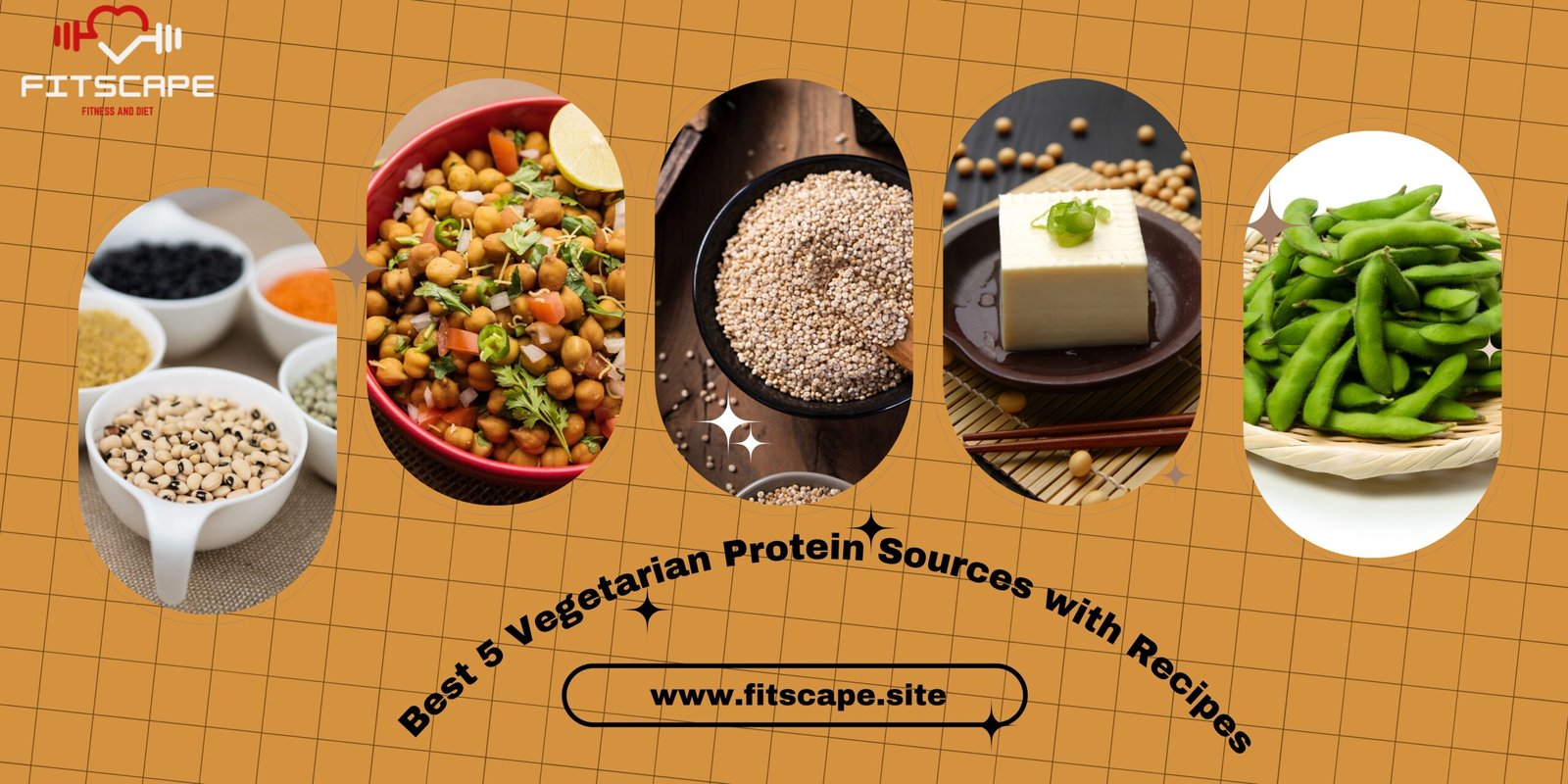Protein is often hailed as the building block of our body, playing a key role in muscle growth, tissue repair, and overall health. For vegetarians, finding high-quality sources of protein is essential to maintain a balanced diet. The good news? There are plenty of plant-based protein options that are not only healthy but also versatile and delicious. Whether you’re a seasoned vegetarian or just looking to explore more plant-based meals, this blog will guide you through five of the best vegetarian protein sources, complete with easy-to-follow recipes to help you incorporate them into your daily meals.
1. Lentils: A Powerhouse of Protein

Lentils are among the best vegetarian protein sources available. Packed with protein, fiber, and essential nutrients, they are a perfect addition to any plant-based diet. With about 18 grams of protein per cooked cup, lentils are incredibly filling and versatile. They’re also rich in iron, folate, and B-vitamins, making them a fantastic choice for boosting overall health.
Recipe: Spicy Lentil Soup
Ingredients:
- 1 cup dried lentils
- 1 onion, chopped
- 2 cloves garlic, minced
- 1 carrot, diced
- 1 tomato, chopped
- 1 tsp cumin powder
- 1 tsp turmeric
- 1 tsp chili powder
- Salt and pepper to taste
- 4 cups vegetable broth
- 2 tsp olive oil
Instructions:
- Heat olive oil in a large pot over medium heat. Add onion and garlic, sautéing until softened.
- Add the carrots and cook for another 3-4 minutes.
- Stir in the cumin, turmeric, and chili powder, allowing the spices to bloom.
- Add the lentils, tomato, and vegetable broth. Bring to a boil, then reduce heat and simmer for 30-40 minutes, or until lentils are tender.
- Season with salt and pepper. Serve warm.
2. Chickpeas: The Versatile Protein Source

Chickpeas, also known as garbanzo beans, are another excellent source of plant-based protein. With around 15 grams of protein per cooked cup, chickpeas also provide fiber, iron, and magnesium. They are incredibly versatile and can be used in a variety of dishes, from salads to stews.
Recipe: Chickpea Salad with Tahini Dressing
Ingredients:
- 1 can chickpeas, drained and rinsed
- 1 cucumber, diced
- 1 bell pepper, diced
- 1 red onion, thinly sliced
- 2 tbsp olive oil
- 1 tbsp lemon juice
- 2 tbsp tahini
- 1 garlic clove, minced
- Salt and pepper to taste
Instructions:
- In a large bowl, combine chickpeas, cucumber, bell pepper, and red onion.
- In a small bowl, whisk together olive oil, lemon juice, tahini, garlic, salt, and pepper to make the dressing.
- Pour the dressing over the salad and toss to combine.
- Serve chilled or at room temperature.
3. Quinoa seeds: The Complete Protein Grain

Quinoa is one of the few plant-based foods that contain all nine essential amino acids, making it a complete protein. With about 8 grams of protein per cooked cup, quinoa is a fantastic grain to add to your diet. It’s also gluten-free, high in fiber, and rich in antioxidants, making it an all-around superfood.
Recipe: Quinoa Stir-Fry with Vegetables
Ingredients:
- 1 cup quinoa, cooked
- 1 cup broccoli florets
- 1 bell pepper, diced
- 1 carrot, thinly sliced
- 2 tbsp soy sauce
- 1 tsp sesame oil
- 1 tsp ginger, grated
- 2 tbsp green onions, chopped
Instructions:
- Heat sesame oil in a large pan over medium heat. Add ginger and sauté for 1 minute.
- Add the broccoli, bell pepper, and carrot. Stir-fry for about 5 minutes or until vegetables are tender.
- Add the cooked quinoa and soy sauce, stirring to combine.
- Garnish with green onions and serve warm.
4. Tofu: The Protein Powerhouse

Tofu is a staple in many vegetarian and vegan diets due to its high protein content and versatility. With 10 grams of protein per 1/2 cup serving, tofu is an excellent source of plant-based protein. It’s also packed with iron and calcium, supporting bone and muscle health.
Recipe: Tofu Scramble with Spinach and Mushrooms
Ingredients:
- 1 block firm tofu, drained and crumbled
- 1 cup spinach, chopped
- 1/2 cup mushrooms, sliced
- 1/4 tsp turmeric
- Salt and pepper to taste
- 1 tbsp olive oil
Instructions:
- Heat olive oil in a pan over medium heat. Add the mushrooms and sauté until soft.
- Add the crumbled tofu and turmeric, cooking for 5-7 minutes, stirring occasionally.
- Add the spinach and cook for another 2-3 minutes until wilted.
- Season with salt and pepper and serve.
5. Edamame beans: The Protein-Rich Snack

Edamame, or young soybeans, are packed with protein, fiber, and essential vitamins. With about 17 grams of protein per cup, they’re an excellent snack or side dish. They are also rich in antioxidants and have been linked to improved heart health.
Recipe: Garlic Edamame Beans
Ingredients:
- 2 cups edamame in pods
- 2 cloves garlic, minced
- 1 tbsp olive oil
- 1 tbsp soy sauce
- Salt to taste
Instructions:
- Steam edamame according to package instructions.
- Heat olive oil in a pan and sauté the garlic until fragrant.
- Add the edamame to the pan, toss with soy sauce and cook for 2-3 minutes.
- Season with salt and serve.
How to Incorporate These Proteins into Your Diet

Incorporating these protein-rich vegetarian sources into your diet doesn’t have to be complicated. Start by adding them to your meals as main ingredients, snacks, or side dishes. You can even combine multiple protein sources in a single meal to increase your protein intake.
Conclusion

Getting enough protein as a vegetarian is easier than you might think! By incorporating lentils, chickpeas, quinoa, tofu, and edamame into your meals, you can enjoy a variety of delicious and nutritious dishes while meeting your protein needs. Whether you’re making a hearty soup or a quick stir-fry, these plant-based protein sources are perfect for fueling your body and supporting your fitness goals.
FAQs
A vegetarian should aim for about 0.8 grams of protein per kilogram of body weight per day, but active individuals may require more.
Absolutely! With the right protein sources and exercise, building muscle on a vegetarian diet is possible.
Other sources include tempeh, seitan, nuts, seeds, and plant-based protein powders.
Focus on incorporating a variety of plant-based protein sources like legumes, grains, and soy products.
Yes, plant-based proteins can be just as effective for muscle growth when consumed in the right amounts and variety.







